
From Puerto Escondido Mexican Hwy 131, pueblo in Oaxaca mountains.
After the post on Mexico’s social medicine system, I thought it would be a good idea to report on the private medical system. However, we’re getting to know it first hand as Bruce has encountered unexpected health problems. Two weeks ago he had neck pain that progressed to shoulder pain and the inability to raise his left arm. He has strength in forearm and biceps but is unable to raise the left arm from the shoulder. My concern was a herniated disc so we consulted with an orthopedic physician in Puerto who diagnosed him with a rotator cuff tear…to my relief. Bruce was doubtful as there was no precipitating cause….although he claims it was the neck massage I gave him. The neck pain started to get worse as well as limited range of motion. In sum, with several anti-inflammatory meds this all became so painful and limiting we are now in Oaxaca city for in depth appropriate testing and medical care (not available in Puerto).
We stopped for fresh squeezed orange juice on the way to Oaxaca.

We arrived 5 days ago and have consulted another orthopedic physician who ordered neck xrays and an MRI of his shoulder. He does have a partial rotator cuff tear and nerve root compression (pinched nerve). Fortunately, the recommended treatment is a conservative approach which is usually successful but will take time. Over the last 5 days he received a cortisone injection in the most inflamed portion of his shoulder and another one in the neck at the facet of the culprit nerve root. Thus far, he has some relief from the pain and improvement in raising his arm. He starts physical therapy on Monday and training for proper neck and shoulder exercises which we can do on our own.
 With the running around we have to do we're exploring more of Oaxaca city. We're finding it more beautiful that our previous visit. Plus, Oaxaca is known for some of the most flavorful food in the Americas...possibly el mundo.
With the running around we have to do we're exploring more of Oaxaca city. We're finding it more beautiful that our previous visit. Plus, Oaxaca is known for some of the most flavorful food in the Americas...possibly el mundo.
Under the circumstances the experience has been pleasant. The appointment with Dr. Bernardo Herrera Juarez was made on Sunday night when we arrived. He met us at his office at 11am on Monday, had the MRI and xray on Tuesday, he saw us again to review the studies on Wednesday. Shoulder and neck injections were done on Monday and Wednesday, respectively.
Costs in Pesos: Appt w/ortho in Puerto 530
Appt w/ortho in Oaxaca 500 x 2 visits=1000 pesos
Meds 366
Taxis 285
Xray 500
MRI 2700 (MRIs are around $1800-3500USDs in the states)
Total cost: 5381 pesos ($365 USDs)
Other than the pain, limited range of motion, and inability to get comfortable, the worst part is lack of sleep. In Mexico only certain physicians can write a prescription for Ambien, a well known sleeping aid not prescribed frequently here and known as a controlled substance. In the US just about any MD or PA can prescribe this medication, however to buy most US prescribed antibiotics, anti-inflammatory meds no prescription is needed.

Bruce has concluded that as the body arrives in it's 6th decade of life that muscular conditioning is important to maintain sound structural physical health. Spending too much time on the computer for the last 20 years, and driving around the countryside the last 7 months has done little to keep the shoulders and neck stong. Hence, from here on out a basic physical routine will be established to prevent further problems.










